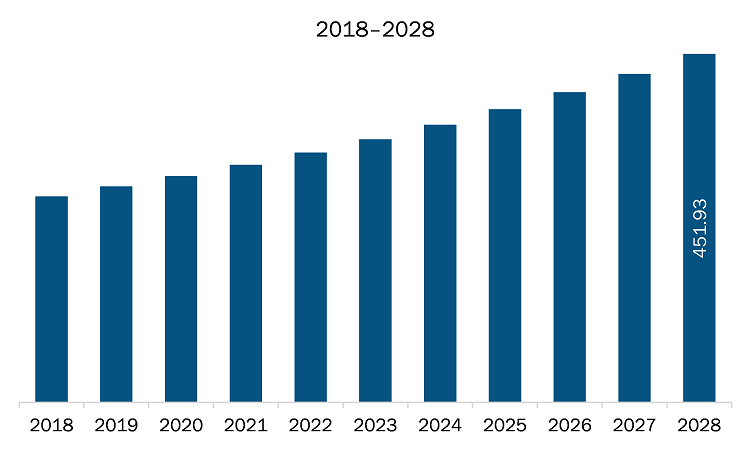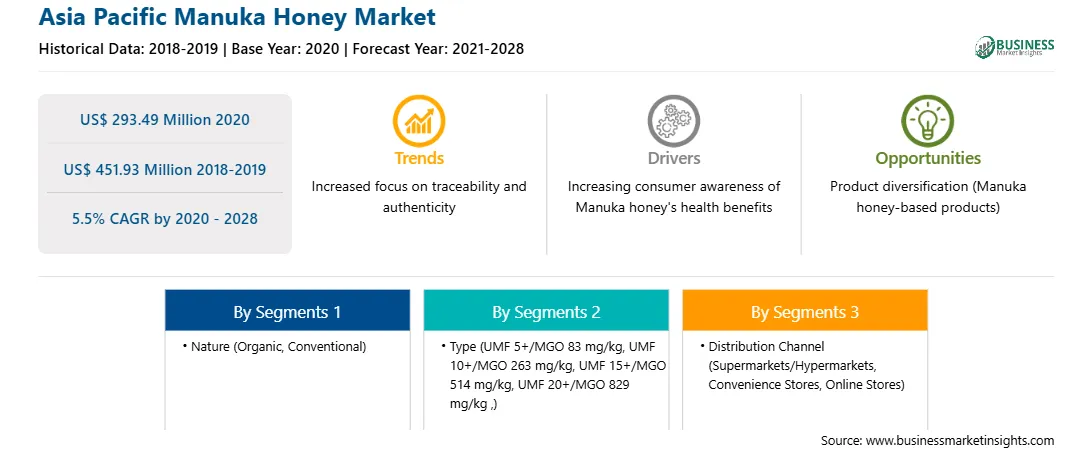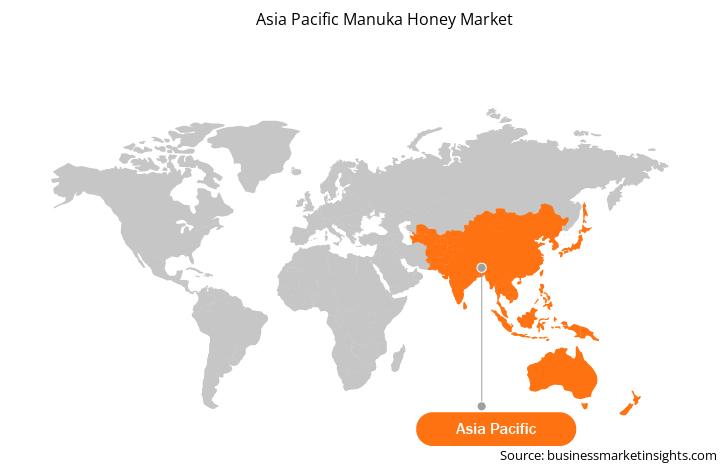APAC market comprises several developing and developed economies, such as Australia, China, India, Japan, and South Korea. These developed and developing countries are witnessing growth in the middle-class population along with growth in urbanization, which offers several opportunities for the key market players in the manuka honey market. The manuka honey industry in the countries of Asia Pacific has experienced a huge shift over the years. China and India are among the leading manuka honey consuming countries across Asia Pacific. Increasing health awareness among the consumers is further expected to bolster the market growth. The rising demand for healthy food is one of the main reasons that supports the growth of manuka honey in Asia Pacific. Hectic lifestyle along with wellness concerns have changed the eating pattern among the population, which favours the growth of manuka honey market in the region. Further, the manuka honey consumption in Asia Pacific has increased owing to the rising disposable income and the availability of manuka honey in the different forms on online and offline retail shops. An upsurge in the purchasing power coupled with the increased spending by millennials on nutrition rich food drives the growth of the manuka honey market in the region.
Coronavirus pandemic first began in December 2019, and since then, it has spread at a fast pace across the world. The coronavirus pandemic has affected economies and industries in various countries due to lockdowns, travel bans, and business shutdowns. The food & beverages industry is one of the major industries suffering serious disruptions such as supply chain breaks, technology events cancellations, shutdown of production plants, etc., because of this pandemic. The shutdown of various plants and factories in leading regions such as North America has affected the global supply chain and negatively impacted the manufacturing, delivery schedules, and sales of various goods. Furthermore, various companies have already announced possible delays in product deliveries and slump in future sales of their products. All these factors are anticipated to affect the food & beverages, personal care, and animal feed industries in a negative manner and thus act as restraining factor for the growth of various markets related to this industry in the coming months. The market for manuka honey is impacted by the pandemic due to shortfall in production along with limited transportation facilities. The COVID-19 is anticipated to cause a significant economic loss in the Asia-Pacific region. The consequence and impact can be even worse and totally depends on the spread of the virus. The governments of various Asia-Pacific countries are taking possible steps to restrict the spread of the virus by announcing lockdown, which in turn has negatively impacted the revenue generated by the manuka honey market.

Strategic insights for the Asia Pacific Manuka Honey provides data-driven analysis of the industry landscape, including current trends, key players, and regional nuances. These insights offer actionable recommendations, enabling readers to differentiate themselves from competitors by identifying untapped segments or developing unique value propositions. Leveraging data analytics, these insights help industry players anticipate the market shifts, whether investors, manufacturers, or other stakeholders. A future-oriented perspective is essential, helping stakeholders anticipate market shifts and position themselves for long-term success in this dynamic region. Ultimately, effective strategic insights empower readers to make informed decisions that drive profitability and achieve their business objectives within the market.

| Report Attribute | Details |
|---|---|
| Market size in 2020 | US$ 293.49 Million |
| Market Size by 2028 | US$ 451.93 Million |
| Global CAGR (2020 - 2028) | 5.5% |
| Historical Data | 2018-2019 |
| Forecast period | 2021-2028 |
| Segments Covered |
By Nature
|
| Regions and Countries Covered | Asia-Pacific
|
| Market leaders and key company profiles |
The geographic scope of the Asia Pacific Manuka Honey refers to the specific areas in which a business operates and competes. Understanding local distinctions, such as diverse consumer preferences (e.g., demand for specific plug types or battery backup durations), varying economic conditions, and regulatory environments, is crucial for tailoring strategies to specific markets. Businesses can expand their reach by identifying underserved areas or adapting their offerings to meet local demands. A clear market focus allows for more effective resource allocation, targeted marketing campaigns, and better positioning against local competitors, ultimately driving growth in those targeted areas.

The manuka honey market in Asia Pacific is expected to grow US$ 451.93 million by 2028 from US$ 293.49 million in 2020. The market is estimated to grow at a CAGR of 5.5% from 2020 to 2028. Manuka honey is made from the nectar of the manuka tree and is only produced in Australia and New Zealand. The key active ingredient in manuka honey is methylglyoxal. This is an antibacterial organic compound that can be used for medicine and everyday health benefits. The key behind this is that bacteria cannot become resilient to methylglyoxal like they can to antibiotics, and antibiotic resistant bacteria. Various species of bacteria, such as Streptococcus and Staphylococcus aureus are prone to manuka honey. Manuka honey also appears to be effective against Clostridium difficile, a hard-to-treat bacteria that infects bowel and causes diarrhea. Also, it is said that manuka honey seems to attack infectious bacteria that form a biofilm, or a thin, slippery layer of bacteria for the reason that once an infection has formed a biofilm, it’s measured to be untreatable. Till date, there are no reports or evidence of microbial resistance to honey, which suggests that it might be effective against long-lasting wound infections and resistant organisms that do not heal with regular antibiotic therapy. Additionally, manuka honey is used for skincare purposes as it helps reduce inflammation and irritation associated with acne. Consumers directly apply a thin layer of manuka honey to the affected area of the skin. The rising prevalence of diseases due to unhealthy lifestyle has increased the awareness regarding healthy diets and the prevention of health disorders such as diabetes, stroke, heart diseases, and obesity. An upsurge in the number of people suffering from celiac diseases results in the increasing demand for gluten free products. Consumers are becoming aware about the ill effects associated with gluten consumption; therefore, they are increasingly opting gluten-free products such as manuka honey. Therefore, all these factors are driving the growth of the manuka honey market.
Asia Pacific manuka honey market is segmented based on nature, type, and distribution channel Based on nature, the Asia Pacific manuka honey market based on nature is segmented into organic and conventional. The conventional segment accounted for the highest share in the market in 2020 and organic segment is expected to be fastest growing during forecast period. Based on type, is segmented into UMF 5+/MGO 83 mg/kg (ppm), UMF 10+/MGO 263 mg/kg (ppm), UMF 15+/MGO 514 mg/kg (ppm), and UMF 20+/MGO 829 mg/kg (ppm). The UMF 15+/MGO 514 mg/kg (ppm) segment accounted for the highest share in 2020 and UMF 20+/MGO 829 mg/kg (ppm) segment is expected to be the fastest growing during forecast period. Based on distribution channel, the market is segmented into supermarkets/hypermarkets, convenience stores, online stores and others. The supermarket/hypermarket segment accounted for the highest share in 2019 and online store segment is expected to be the fastest growing during forecast period.
A few major primary and secondary sources referred to for preparing this report on manuka honey market in Asia Pacific are company websites, annual reports, financial reports, national government documents, and statistical database, among others. Major companies listed in the report are 100% Pure New Zealand Honey; Arataki Honey; Comvita; Manuka Health; Oha Honey; Midlands Holdings; Capilano Honey Ltd; Streamland; Three Peaks Manuka Honey; and Wedderspoon Organic.
The Asia Pacific Manuka Honey Market is valued at US$ 293.49 Million in 2020, it is projected to reach US$ 451.93 Million by 2028.
As per our report Asia Pacific Manuka Honey Market, the market size is valued at US$ 293.49 Million in 2020, projecting it to reach US$ 451.93 Million by 2028. This translates to a CAGR of approximately 5.5% during the forecast period.
The Asia Pacific Manuka Honey Market report typically cover these key segments-
The historic period, base year, and forecast period can vary slightly depending on the specific market research report. However, for the Asia Pacific Manuka Honey Market report:
The Asia Pacific Manuka Honey Market is populated by several key players, each contributing to its growth and innovation. Some of the major players include:
The Asia Pacific Manuka Honey Market report is valuable for diverse stakeholders, including:
Essentially, anyone involved in or considering involvement in the Asia Pacific Manuka Honey Market value chain can benefit from the information contained in a comprehensive market report.